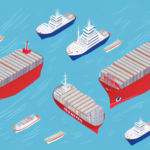Importance of Cargo Insurance
As a business owner, safeguarding your shipments against potential risks is essential. Cargo insurance provides this protection, ensuring that your goods are covered from the moment they leave your warehouse until they reach their destination. Accidents, theft, and unforeseen circumstances can lead to significant financial losses, making cargo insurance a critical component of your shipping strategy.
Why Cargo Insurance is Important for Your Business
Cargo insurance protects businesses from various financial risks during the shipping process, including theft, damage, or loss of goods in transit. According to the Bureau of Transportation Statistics, shipping-related losses can account for up to 5% of total annual revenues for certain industries. Having the right insurance coverage mitigates the impact of these potential losses, ensuring business continuity and financial stability.
Types of Cargo Insurance Policies
Selecting the appropriate cargo insurance policy depends on your specific needs and the nature of your shipments. Understanding the different types of policies available can help you make an informed decision.
All-Risk Policies
All-risk policies provide comprehensive coverage, protecting against a wide range of risks unless explicitly excluded in the policy. This type of coverage is ideal for high-value or fragile goods, offering peace of mind by covering most potential losses.
Named-Perils Policies
Named-perils policies cover only the specific risks listed in the policy, such as fire, theft, or natural disasters. While generally more affordable than all-risk policies, they offer less comprehensive protection.
Domestic vs. International Cargo Insurance
Domestic cargo insurance covers shipments within a single country, typically offering lower premiums due to reduced risk. In contrast, international cargo insurance encompasses global shipping routes and includes coverage for additional risks like political instability and customs issues. According to the Insurance Research, international shipments are subject to higher premiums due to increased complexity and risk factors.
Factors Influencing Cargo Insurance Costs
The cost of cargo insurance varies based on several factors. Understanding these can help you anticipate expenses and manage your shipping budget effectively.
Value of Goods
The total value of the goods being shipped directly impacts the insurance premium. Higher-value items naturally incur higher insurance costs to cover potential losses adequately.
Shipping Method
Different modes of transportation carry varying levels of risk. Air freight, for example, is generally more expensive to insure than sea freight due to the higher risk of damage or loss. The International Civil Aviation Organization reports that air shipments have a higher rate of incident per ton-mile compared to other shipping methods.
Destination
Shipment destinations with higher risks, such as regions with political instability or poor infrastructure, can lead to increased insurance premiums. Utilizing data from the World Bank, insurers assess destination risk factors to determine appropriate coverage rates.
Type of Goods
Certain goods, especially hazardous materials, require specialized insurance policies and can significantly increase premium costs due to the inherent risks involved.
Calculating and Reducing Cargo Insurance Costs
Effective management of cargo insurance involves both accurate cost calculation and strategies to minimize premiums without compromising coverage.
Calculation Methods
To calculate the cost of cargo insurance, consider the following formula:
- Premium = (Value of Goods) x (Rate per $100)
For example, insuring goods valued at $50,000 with a rate of 0.5% would result in a premium of $250.
Cost-Reduction Strategies
- Bundle Shipments: Consolidating multiple shipments can lead to discounts.
- Increase Deductibles: Opting for higher deductibles can lower premium costs.
- Improve Packaging: Properly packaging goods reduces the risk of damage, potentially lowering insurance costs.
- Accurate Valuation: Declaring the correct value of goods prevents overpayment of premiums.
According to the Insureon Insurance Report, businesses implementing these strategies have seen up to a 20% reduction in their cargo insurance premiums.
Choosing the Right Cargo Insurance Provider
Partnering with a reputable cargo insurance provider ensures reliable coverage and efficient claims processing. Evaluating providers based on their offerings and reputation is crucial for optimal protection.
Working with Reputable Providers
Opt for insurance companies with a proven track record in the cargo industry. Companies like Allianz and AXA are renowned for their comprehensive cargo insurance solutions and customer service.
Evaluating and Comparing Providers
When comparing insurance providers, consider the following factors:
- Coverage Options: Ensure the policy covers the specific risks associated with your shipments.
- Claims Process: A streamlined and efficient claims process is vital in the event of a loss.
- Customer Reviews: Feedback from other businesses can provide insights into the provider’s reliability.
- Cost: Balance premium costs with the level of coverage offered.
Role of Freight Forwarders
Freight forwarders can assist in obtaining cargo insurance by leveraging their industry connections and expertise. They often have partnerships with insurance providers, enabling businesses to access competitive rates and tailored coverage options.
Managing Cargo Insurance Claims
Understanding the claims process and the coverage details of your cargo insurance policy is essential for effectively managing any potential losses.
Common Claims
Typical claims under cargo insurance include:
- Theft or pilferage
- Damage due to accidents or improper handling
- Loss from natural disasters such as floods and earthquakes
Each claim type requires specific documentation and evidence to support the claim's validity.
Policy Exclusions and Limitations
Cargo insurance policies may have exclusions, such as:
- Losses due to war or terrorism
- Damage from inadequate packaging
- Pre-existing conditions of the goods before shipping
It's crucial to thoroughly review your policy to understand these exclusions and ensure adequate coverage for your shipments.
Filing a Claim
To file a cargo insurance claim, follow these steps:
- Notify the Insurer: Inform your insurance provider as soon as possible after the loss or damage occurs.
- Document the Incident: Gather all relevant documentation, including shipment details, photographs, and any correspondence related to the incident.
- Submit the Claim: Complete the necessary claim forms and submit all required documentation to the insurer.
- Follow Up: Maintain communication with the insurance provider to monitor the progress of your claim.
For detailed guidance, refer to the International Risk Management Institute on the cargo insurance claims process.
Future Trends in Cargo Insurance
The cargo insurance landscape is evolving with advancements in technology and changing global trade dynamics. Staying informed about these trends can help businesses adapt and maintain effective insurance strategies.
Technological Advancements
Emerging technologies like blockchain and Internet of Things (IoT) are enhancing transparency and tracking in the shipping industry. These technologies provide real-time data, reducing the risk of loss and improving the accuracy of insurance claims. According to Forbes Tech Council, blockchain can streamline the claims process by providing immutable records of shipment conditions.
Climate Change Impact
Climate change poses new challenges for cargo insurance, with an increase in extreme weather events affecting shipping routes and the integrity of shipments. Insurers are adapting by offering specialized policies that address climate-related risks. Research from the Intergovernmental Panel on Climate Change highlights the growing need for resilient insurance solutions in the face of environmental changes.
Businesses must stay ahead by embracing these trends and working with their insurance providers to ensure comprehensive coverage that addresses both current and emerging risks in the shipping industry.






















